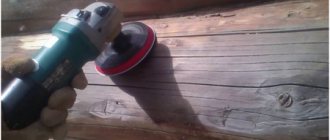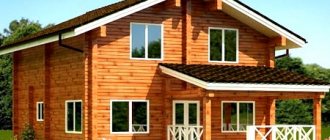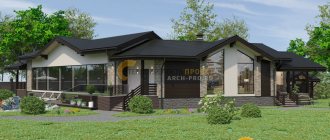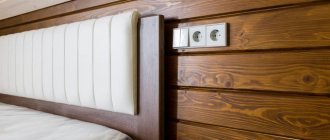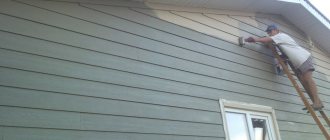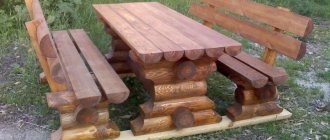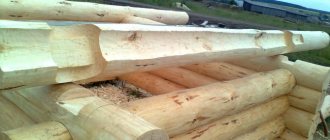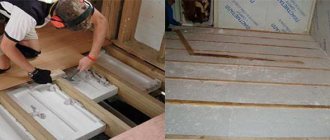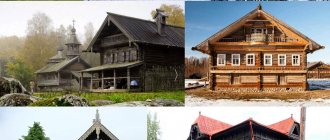Almost every fire suppressant operates on the following principle: in the presence of hot air or an open flame, the fire-retardant layer releases a substance in the form of foam. This foam prevents oxygen from entering and prevents fire from spreading across the wooden surface. The processing of bathhouse logs must be carried out with special means that can withstand temperature changes of up to 110ºC. The best option would be formulations labeled “luxury”.
There are also fire retardants that form a salt film on the surface. These compounds give only a temporary effect, and then the wood must be treated with special solutions.
Why process logs?
Wood is a living material; it is susceptible to fungal infections and mold; in addition, wood can delaminate, dry out, or, conversely, swell. To avoid troubles associated with the properties of wood, it is necessary to carry out processing.
The treatment of the external and internal surfaces of rounded timber differs from each other, since the external walls of the log house are subject to temperature changes, exposure to direct sunlight, precipitation, as well as damage from natural pests. In order to protect the house from the invasion of parasites and from climatic conditions, it is necessary to treat the log house with an antiseptic, which will protect the house from chemical and biological effects.
Inside, the walls of the house are not exposed to aggressive environmental influences, which cannot be said about bathhouses made of wood. In addition to the indicated environmental impact outside on the walls of a wooden frame, inside the bathhouse the walls are affected by elevated temperatures and humidity. Because of this, the need for additional protection of the walls of the bathhouse from the inside is so important.
Not least important is the appearance of the house. Therefore, the treatment is not only functional, but also aesthetic in nature, since almost all impregnation agents for log houses have decorative properties.
The processing of the log house occurs in several stages using various compounds, including:
- antiseptic;
- fire retardant;
- whitening.
Painting works and tools for them
Some have not encountered this type of work, so it will be useful for them to learn all the technical aspects of finishing with lining and painting it.
So, what tools will you need to carry out painting work:
- paint roller;
- paint brushes, the bristles of which should be hard. There should be several of them;
- construction tape;
- sandpaper (grit number 240);
- napkins;
- container for roller and brushes.
Painting tools
Treatment with protective compounds
The quality of your work will depend on attentiveness and accuracy, as well as on the correctness and consistency of compliance with all rules and recommendations. Full instructions are presented in the video:
Pre-grinding
Before treating a log house with impregnation, it requires grinding, which solves a number of issues:
- eliminates roughness;
- masks cracks;
- removes bark;
- makes it look better.
In addition, sanding prepares the logs for impregnation with other substances after this work. Grinding is carried out when the upper surface of the timber dries well. If you try to sand wet wood, it will cause the wood fibers to separate.
Grinding is carried out in several ways:
- First, a grinder and an abrasive disc are used.
- Then a sander and attachments with different degrees of grit are used.
- Afterwards, final sanding is carried out with a fine-grained nozzle.
The sawdust remaining after sanding is removed or used for gardening work. After grinding the rounded timber, you can directly impregnate the log house.
Protection with folk remedies
It is better to treat wood against rotting in dry weather with a low probability of precipitation. It is possible to work with antiseptic coatings even at sub-zero temperatures, but wood is saturated better and dries faster in the warm season, when temperatures reach 5-20 degrees. There should be no wind so that the wet surface is not covered with a layer of dust and dirt.
You should begin work by preparing the tool. In addition to antiseptic compounds, you will need:
- spray bottle (if the consistency of the solution is not viscous);
- roller, brushes;
- plane, sandpaper;
- rags;
- brush with stiff bristles;
- protective equipment (when using toxic coatings).
A more detailed list of necessary tools depends on the chosen method of wood processing.
Pros and cons of treating wood with waste oil
One of the common folk methods of protecting wood from rotting is treating the material with waste oil. Any engine oil that has served its intended period in a car or other equipment is suitable.
Among the advantages of this method:
- minimum costs;
- provides reliable protection against insects, rodents, mold and other microbiological processes;
- preventing early destruction of the wood structure;
- maintaining the density of the material.
When considering this option, one cannot ignore the negative nuances. The disadvantages of using used oil include:
- the technology is applicable only in non-residential buildings;
- the method is suitable for protecting small wooden elements;
- loss of color, damaged appearance of building material;
- oily surfaces are difficult to paint;
- not all types of oil are safe for wood; mineral-based oils have a mild effect;
- surfaces become easily flammable.
Taking into account the advantages and disadvantages of the method, the conclusion suggests itself: mining is an unsafe means of protecting wood, which can cause harm to human health and the structure of the material. It is better to give preference to antiseptic impregnations
Finnish wood processing method
There is a special way of treating wood from rotting and moisture - the Finnish method. It uses a set of available materials:
- flour;
- salt;
- slaked lime;
- inkstone;
- water.
All components must be combined in a spacious container until a homogeneous consistency is obtained. The thickness of the coating resembles sour cream. The finished mixture is placed on the fire and, with constant stirring, heated until warm. While the product has not cooled down, it is applied to wooden surfaces. Once the first layer is completely dry, begin applying the second ball.
This product stays on the boards for a long time and is not washed off with water. Despite its safe composition, the coating is used for material intended for arranging fences and roofing structures.
Liquid glass processing
One of the ways to protect wood from rotting involves applying liquid glass to the surface. The main condition of the technology is that the layer should not be less than 100 microns.
Sequence of work:
- Wear protective equipment (rubber gloves, cotton robe, glasses, closed shoes).
- Level the working surface of the wood, clean up chips.
- Dilute liquid glass with water in the ratio recommended by the manufacturer. It should have the consistency of jelly.
- Wood processing is carried out using a roller or brush. The operating temperature range is from -20 to +40 degrees, that is, in any weather without precipitation or strong wind.
- After the first layer has dried, the second is applied.
Despite all the advantages of liquid glass, it is not recommended to use this method of protecting wood in cases where surfaces are planned to be painted. After applying glass, the wood becomes smooth and a transparent film forms on the surface. The adhesion of wood deteriorates, but the material acquires water-repellent properties. Paint will not adhere to such a surface.
Bleaching agents
To protect the surface of the rounded timber from damage by a fungus that causes blueing of the wood, the log house is additionally treated with bleaching agents:
- "Sagus";
- "Sagoy";
- "Neomid 500";
- “League” is a new drug, notable for the fact that it is able to revive an old tree, rid the log house of blackness and blueness, restoring its former appearance.
First, the log house is treated with a bleaching agent, and then with an antiseptic.
How to treat the walls of a timber house: choosing the means
All existing antiseptics are divided into two types: impregnating and film-forming.
Impregnating agents, as the name implies, penetrate deeply into the wood, and therefore work better and longer. As for film-forming agents, they are best used as a topcoat.
Based on their composition, products are water-based, oil-based or synthetic-based. As a rule, water antiseptics or products based on natural oils are used for interior work. Synthetic-based (organic) products are best used for external treatment of walls - due to the toxicity of the base, that is, organic solvents. The most popular are water-based antiseptics, since they are easier and faster to work with, and they are more affordable and of proper quality.
Another classification of antiseptics is by action. Thus, they produce products that fight mold, fungi and bacteria, bleaching antiseptics, and complex products. At first glance, it seems that complex products are better, but this is not so - it is better to buy a separate antiseptic to solve each problem.
By the way, about whitening compounds. They are also called restorative. These are chloride-based products and are used to restore the color of darkened wood. If any parts of the wall have darkened, it is first treated with a bleaching agent, and then with an antiseptic.
Fire retardants are also worth highlighting in a separate category – products that increase the fire resistance of wood. Treatment with them is carried out a week or two after treatment with antiseptics. You can choose a universal product (antiseptic + fire retardant), but their effectiveness is not so high.
How to choose an antiseptic? Follow these parameters:
- Protection class. For interior work, medium and low are suitable, but if processing is carried out in rooms with high humidity, a high protection class is needed, as for external processing.
- Toxicity - it is clear that for internal work you need to choose a non-toxic product.
- The degree of resistance to various adverse factors.
- Duration of coverage.
- Penetration depth for penetrating agents - the greater the depth, the better.
- Expense of funds.
As for the price-quality ratio, here everyone chooses what suits him. However, there are many products on sale that, at an affordable price, are of good quality.
As for the full treatment, it should begin with the most vulnerable parts of the house - joists, bottom frame beams, subfloor.
How to process profiled timber for the bottom frame of a house?
Primary treatment, both with antiseptics and fire retardants, is carried out at the construction stage. Repeated treatment is carried out during shrinkage of the house. Finishing is carried out using products with the highest protection class.
Materials taken from Wikipedia or other open sources of information.
Antiseptic treatment
Antiseptic impregnation is used to increase the service life of wooden structures and is carried out both inside and outside the house and bathhouse. Antiseptics prevent the development and proliferation of bacteria inside the walls. The initial impregnation with an antiseptic is carried out by the manufacturer of the rounded timber, after which the wood is aged for at least another six months to a year for complete drying and only then is it delivered to the site.
Easy-to-clean and difficult-to-clean antiseptic formulations are used to treat internal and external surfaces. Easily washable ones dry quickly and are less resistant to moisture; they are applied to internal surfaces. Hard-to-wash types dry extremely slowly, but are quite resistant to washing out by precipitation, and are recommended for external processing of rounded timber.
Antiseptic preparations used for external surfaces of timber:
- “Neomid 440” (protects timber from bacteria, fungal diseases and viruses for up to 15 years);
- “Aquatex” (in addition to the main protective functions, it gives the timber the appearance of valuable wood, and also protects the walls of the bathhouse from rotting, water, and sunlight);
- "Prosept ultra";
- "League-Bioshield".
Antiseptics for impregnating the inside of a log house:
- "Neomid 430";
- "Prosept Interior".
The antiseptic is made using synthetic and natural oils, which are able to penetrate into the wood fibers, after which they form a stable compound. Coating with antiseptic drugs is carried out in several stages. Each subsequent layer can be applied only after the previous one has completely dried. Processing is not allowed until the rounded timber has dried out, or in wet weather.
What to protect from
During operation, timber and rounded logs are subjected to various loads, the effects of which can be neutralized by compositions of narrowly targeted or universal action. Several types of substances are suitable for processing upon completion of log house construction:
- antiseptics prevent the spread of microorganisms, fungi, insects;
- a huge risk for housing is created by the flammability of wood, which can be reduced with fire retardants;
- the tendency to rot and destruction increases under the influence of moisture, and special water-repellent compounds can block access to the wood;
- Intense sun rays, which can discolor and dry out the material, causing it to crack, have a powerful effect on the outer surface of log houses. UV protection significantly reduces the negative impact of radiation from the sun on the log house.
The specificity of the influence of substances is that some of them should penetrate deep into the material, and the other should concentrate outside.
Fire retardant treatment
Since wood is highly flammable, first of all, you need to think about fire protection. Fire retardants must be used for processing log wood in any case.
For fire-prevention impregnation the following means are used:
- “Neomid 530” - in addition to fire-fighting properties, it has protection against biological damage, as well as decorative properties.
- "Senezh Ognebio" - provides protection against rotting, fire, and insect pests.
- "Phenilax" - protects against fire and internal damage, penetrating deep into the wood.
- “KSD” is a product that, in addition to fire-retardant properties, is an antiseptic.
- "Pirilax SS-20" - used to treat the walls of the bathhouse inside.
- "Pirilax 3000" - this product is used to treat the outside of baths.
Fire protection occurs when the rounded timber is exposed to open flames or high temperatures. After a fire, a foam layer appears on the treated walls of the log house, which stops the access of oxygen to the surface and prevents the fire from spreading.
Treatment of wood affected by bark beetle
The treatment process is as follows:
- Places where shashel larvae accumulate are determined (by sound or crumbling shavings). These areas are then marked with a marker.
- Using a long drill, holes are drilled into the wood with a depth of at least 1/3 of the thickness of the timber. Drilling is carried out at different angles to the surface.
- The affected surface is cleaned of dirt and dust with a metal brush. It leaves scratches on the wood, through which the antiseptic will seep deep into the wood, which increases the effectiveness of the treatment.
- The prepared surface is treated with a foam roller impregnated with an antiseptic composition. An antiseptic is injected into the holes made with a syringe.
It is advisable to carry out the treatment in the warm season and in a well-ventilated area. Usually, no later than an hour later, you can observe the process of migration of insects from the tree. If necessary, the treatment can be repeated.
Tasks for painting walls from the inside:
- The coating protects the wall from dirt and abrasions. The sanded surface is easy to stain - the dirt eats into the wood, and sometimes you have to remove a layer of wood to remove it. It is much easier to wash off dirt from a painted wall.
- Paint is needed to protect against high humidity and direct ingress of water. If it is decided to leave exposed wood in the “wet zone,” then the walls are painted with a waterproof compound or covered with a moisture-resistant impregnation. This technology is used in bathrooms, swimming pools, and kitchen work areas.
- The right shade helps solve design problems. The color of the walls is chosen taking into account the purpose of the rooms: calm shades for bedrooms, neutral shades for common areas, bright shades for the kitchen and living room. It is important not to overdo it with saturation, otherwise the walls can visually reduce the volume of the room.
Bedroom in a house according to the SV-4 project
What and how to paint the outside of a log house
To cover the outside of a building, compositions are selected that are resistant to natural factors; operating conditions are difficult; the following are suitable for this purpose:
- Glazing colorless varnishes, they are used if there is a desire to preserve the wood pattern;
- Covering opaque varnishes, the coating will have a beautiful shine, creating a barrier against wood-boring beetles and others, mold and mildew;
- Oil-based materials are distinguished by deep penetration into the material, but are long-drying and the brightness of the color is short-lived;
- Acrylic, optimal combination of protective properties;
- Alkyd, high barrier property, but not vapor permeable;
- Yacht look, particularly resistant to moisture;
- Stain can create the necessary protective properties, but in addition you should paint the varnish;
- Oils and wax coatings are harmless products that are inexpensive.
To cover the outside of the building, compositions that are resistant to natural factors are selected.
